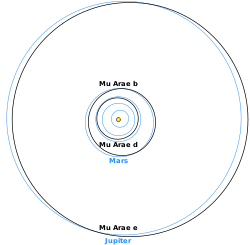ميو المجمرة
Mu Arae | |
| بيانات الرصـد الحقبة J2000.0 اعتدال J2000.0 | |
|---|---|
| الكوكبة | Ara |
| الصعود المستقيم | 17س 44د 08.70114ث[1] |
| الميل | −51° 50′ 02.5853″[1] |
| القدر الظاهري (V) | +5.12 |
| الخـصـائص | |
| النوع الطيفي | G3IV–V[2] |
| U-B دليل الألوان | +0.24[3] |
| B-V دليل الألوان | +0.70[3] |
| R-I دليل الألوان | 0.2 |
| علم القياسات الفلكية | |
| السرعة القطرية (Rv) | −9.0[4] كم/ث |
| الحركة الحقيقية (μ) | RA: −16.85[1] mas/yr Dec.: −190.60[1] mas/س |
| اختلاف المنظر (π) | 64.47 ± 0.31[1] mas |
| المسافة | س ض ( ف ن) |
| القدر المطلق (MV) | +4.17[5] |
| التـفـاصـيل | |
| الكتلة | 1.10 ± 0.01[6] M☉ |
| نصف القطر | 1.36 ± 0.01[6] R☉ |
| الضياء | 1.90 ± 0.10[6] L☉ |
| جاذبية السطح (ج) | 4.19[2] س.ج.ث. |
| درجة الحرارة | 5820 ± 40[6] ك |
| المعدنية | 200 ± 5%[6][note 1] |
| المعدنية [Fe/H] | 0.30 ± 0.01[6] العشرية |
| الدوران | 31 days |
| تسارع الدوران (v sin i) | 1.4[7] كم/ث |
| العمر | 6.34 ± 0.40[6] م.س. |
| تسميات أخرى | |
| مراجع قواعد البيانات | |
| SIMBAD | data |
| ARICNS | data |
| Extrasolar Planets Encyclopaedia | data |
مو المجمرة (آراي) Mu Arae (μ Ara / μ Arae) هو خامس أكبر نجم من نوع جي ذو لون اصفر-برتقالي شبيه بالشمس. يتبعد مسافة 49.8 سنة ضوئية وقد وجد في المجرة ارا Ara وهو ظاهر بالعين المجردة. وله تقريباً 108% من كتلة الشمس وأكبر بنسبة 32%.
النظام الكوكبي

The orbits of the outer three planets in the Mu Arae system compared to those in the Solar System. Central star is not to scale. At the scale of this picture, the innermost planet would be located at the edge of the disc representing the central star.
الاكتشاف
| المرافق (بالترتيب من النجم) |
الكتلة | نصف المحور الرئيسي (و.ف.) |
الدور المداري (يوم) |
الانحراف | الميل | نصف القطر |
|---|---|---|---|---|---|---|
| c (Dulcinea) | >10.5551 M⊕ | 0.09094 | 9.6386 ± 0.0015 | 0.172 ± 0.04 | — | |
| d (Rocinante) | >0.5219 MJ | 0.921 | 310.55 ± 0.83 | 0.0666 ± 0.0122 | — | |
| b (Quijote) | >1.676 MJ | 1.497 | 643.25 ± 0.90 | 0.128 ± 0.017 | — | |
| e (Sancho) | >1.814 MJ | 5.235 | 4205.8 ± 758.9 | 0.0985 ± 0.0627 | — |
انظر أيضاً
ملاحظات
- ^ From [Fe/H] = 0.30 ± 0.01
المراجع
- ^ أ ب ت ث ج van Leeuwen, F. (November 2007). "Validation of the new Hipparcos reduction". Astronomy and Astrophysics. 474 (2): 653–664. arXiv:0708.1752. Bibcode:2007A&A...474..653V. doi:10.1051/0004-6361:20078357.
- ^ أ ب Gray, R. O.; et al. (July 2006). "Contributions to the Nearby Stars (NStars) Project: Spectroscopy of Stars Earlier than M0 within 40 parsecs: The Northern Sample I". The Astronomical Journal. 132 (1): 161–170. arXiv:astro-ph/0603770. Bibcode:2006AJ....132..161G. doi:10.1086/504637.
- ^ أ ب Feinstein, A. (1966). "Photoelectric observations of Southern late-type stars". The Information Bulletin for the Southern Hemisphere. 8: 30. Bibcode:1966IBSH....8...30F.
- ^ Wielen, R.; et al. (1999). "Sixth Catalogue of Fundamental Stars (FK6). Part I. Basic fundamental stars with direct solutions". Veröff. Astron. Rechen-Inst. Heidelb. Astronomisches Rechen-Institut Heidelberg. 35 (35): 1. Bibcode:1999VeARI..35....1W.
- ^ Anderson, E.; Francis, Ch. (2012). "XHIP: An extended hipparcos compilation". Astronomy Letters. 38 (5): 331. arXiv:1108.4971. Bibcode:2012AstL...38..331A. doi:10.1134/S1063773712050015.
- ^ أ ب ت ث ج ح خ Soriano, M.; Vauclair, S. (2009). "New seismic analysis of the exoplanet-host star Mu Arae". Astronomy and Astrophysics. 513: A49. arXiv:0903.5475. Bibcode:2010A&A...513A..49S. doi:10.1051/0004-6361/200911862.
- ^ Bruntt, H.; et al. (July 2010). "Accurate fundamental parameters for 23 bright solar-type stars". Monthly Notices of the Royal Astronomical Society. 405 (3): 1907–1923. arXiv:1002.4268. Bibcode:2010MNRAS.405.1907B. doi:10.1111/j.1365-2966.2010.16575.x.
- ^ خطأ استشهاد: وسم
<ref>غير صحيح؛ لا نص تم توفيره للمراجع المسماةpepe
<ref> ذو الاسم "McCarthy2004" المُعرّف في <references> غير مستخدم في النص السابق.وصلات خارجية
- GJ 691
- HR 6585
- Britt, Robert Roy (25 August 2004). "'Super Earth' Discovered at Nearby Star". Space.com. Retrieved 17 July 2008.
- "Fourteen Times the Earth". European Southern Observatory. 25 August 2004. Archived from the original on 7 June 2007. Retrieved 17 July 2008.
- "Mu Ara: a system with 4 planets". Geneva Observatory. Retrieved 17 July 2008.
- "Mu Arae". SolStation. Retrieved 17 July 2008.
- Image Mu Arae
- Extrasolar Planet Interactions by Rory Barnes & Richard Greenberg, Lunar and Planetary Lab, University of Arizona
This article may include material from Wikimedia licensed under CC BY-SA 4.0. Please comply with the license terms.
